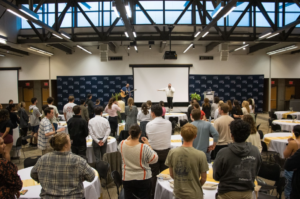Architecture Lecture Series “Future of the Practice”
By: Kat Kaderabek
The School of Architecture and Planning hosted two lecturers, John Schippers and Phil Read, on Monday, February 3. Held in the Koubek auditorium in Crough and attended by the majority of architecture students and professors, the lecture was intended to be focused on developing technology.
However, the pair delivered a rather rattling and unexpected presentation. Schippers, an architect-affiliate with a primary focus in technology, began his lecture entitled, “Future of the Practice.”
Schippers delivered several insightful tips on technology and its development in the architecture profession. Schippers, who is a co-author of the book, Mastering Revit, focused on the importance of this specific rendering software throughout the majority of his lecture. However, he also noted key programs that are rather unknown and which he believes are invaluable to the architecture community.
One program is Hypar, a program that generates basic building shapes that can then be molded by the architect before being loaded into the Revit software. What this means for architects, is that building designs may take even less time to model, since this Hypar program can generate them quicker and more efficiently than if an architect were to design it.
However, this program has the potential to take away a factor of the creative process. Oftentimes, buildings are rather specific in their orientation and would not be able to use any pre-scripted templates. The Hypar program would be best suited for generic, multi-family housing. Even construction industries could use this program in the development process, according to Schippers.
The concept that the construction industry can suddenly creep into the realm of architecture was Read’s focus in his jarring and eye-opening lecture. While Schippers had mostly outlined key programs and the possibility technology brings to the field of architecture, Read almost completely discredited the field of architecture in his lecture.
Schippers showcased the benefits of augmented reality with the interaction between the creators and holographic objects, but Read reminded the audience that technology will eventually make the architecture profession obsolete. The problem with architecture is the “lack of entrepreneurism” and the “undervaluing of time and compensation” according to Read.
“Technology is rendering the architectural profession irrelevant,” said Read. After his opening comments, he shifted to the business side of the profession. While Read offered a different viewpoint on the field, his delivery was rather offensive to the gathered crowd of students and faculty.
He instructed the room full of college students “not to trade debt for status.” Instead, he noted that knowledge is free, and so is the internet. Read explained that everything the students are currently learning can be understood using free platforms such as YouTube. He then proceeded to show several slides comparing the starting salaries of a college-educated person with a four-year bachelor’s degree to a technically-educated person with a two-year certificate. The starting salaries were relatively the same, with only a few hundred dollars as the difference.
Although Read approached this lecture bluntly, he incorporated several helpful tips that many college students were ignorant to. His business advice included tips such as how to calculate one’s billable rate, and the importance of having equity.
“Buy tools. Not toys,” Read instructed. He emphasized the importance of what is necessary, namely the materials and the programs, over what is wanted.
Overall, Read wishes for all architects to get into the position to say no, rather than rely on every project that is presented. Architects should think of money in terms of experience and time. He concluded with a final note, instructing all students to “become an owner as soon as possible” and to avoid debt at all costs.
As a result of this lecture, the Dean Ott of the School of Architecture and Planning has since issued an email to the students and faculty addressing the material in the lecture.
“We can hear what we heard last night and process it productively for our own purposes, using the very educational tools that were rather harshly criticized,” Ott commented.
“We will weather these predictions as we have weathered others. We can listen to such thoughts, reflect on them, and ask ourselves the relevant questions. We can do this without fear,” said Ott.
Professor CJ Howard added to this sentiment in an addressment of the lecture in his Construction II class. “Architecture is a vocation,” he explained. “Business is only a part of that.”
While the lecture series topics were unexpected and somewhat upsetting to the audience, there were several nuggets of truth to Read’s presentation that many of the students and faculty will remember. Schipper’s presentation was full of tips and tricks that many in attendance were unaware of, which made his lecture a productive and insightful one. And while Read’s work was rather demoralizing, his intention was to be realistic and responsatory.
The lecture in its totality provided an extensive background in technology and a different viewpoint of the profession that its original perception.






